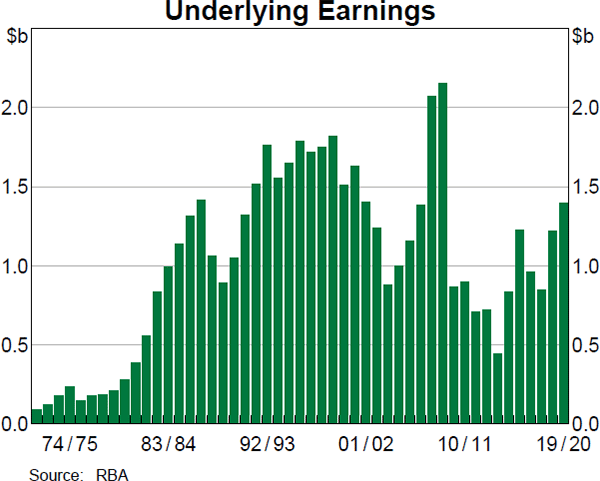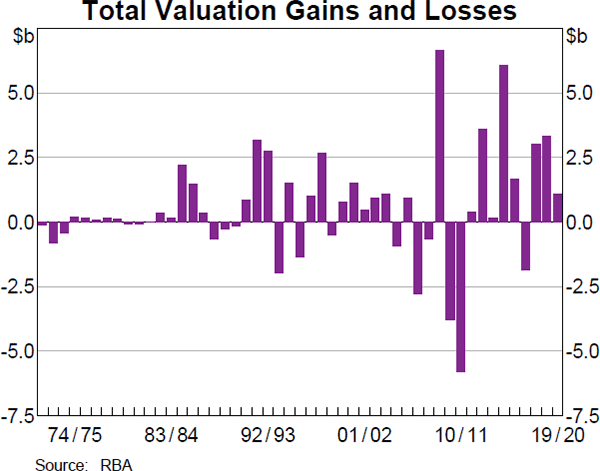Reserve Bank of Australia Annual Report – 2020 Earnings, Distribution and Capital
The Reserve Bank recorded a net profit of $2.5 billion in 2019/20. Earnings available for distribution, as determined by the Reserve Bank Act 1959, amounted to $2.6 billion, with the full sum distributed to the Commonwealth. The Reserve Bank remains well capitalised.
The Reserve Bank's Earnings
The Reserve Bank's earnings come from two sources: underlying earnings, including net interest and fee income, less operating costs; and valuation gains or losses. Net interest income arises from the Bank earning interest on almost all of its assets, albeit currently at low rates, while paying no interest on a large portion of its liabilities, namely banknotes on issue, and capital and reserves. Fees paid by authorised deposit-taking institutions in relation to the Committed Liquidity Facility also contribute to underlying earnings.
Valuation gains and losses result from fluctuations in the value of the Reserve Bank's assets because of movements in exchange rates or changes in the market yields on securities held outright. A depreciation of the Australian dollar or a decline in market yields results in valuation gains. Conversely, an appreciation of the Australian dollar or a rise in market yields leads to valuation losses. These gains and losses are realised only when the underlying asset is sold or matures. Valuation gains and losses are volatile, as both exchange rates and market interest rates can fluctuate in wide ranges over time. Market risk is managed by the Bank within strict parameters, although it is not completely eliminated given the policy purposes for which the Bank's assets are held.
Management of the Bank's assets is discussed in the chapter on ‘Operations in Financial Markets’; the associated risks are outlined in the chapter on ‘Risk Management’.
The Reserve Bank reports net profit as income from all sources, in accordance with Australian Accounting Standards, while the distribution of profits is determined by section 30 of the Reserve Bank Act. In terms of the Act, net profit is dealt with in the following way:
- Unrealised gains (or losses) are not available for distribution and are transferred to (absorbed by) the unrealised profits reserve. The remainder of net profit after this transfer is available for distribution.
- The Treasurer determines, after consulting the Reserve Bank Board, any amounts to be placed from distributable earnings to the credit of the Reserve Bank Reserve Fund (RBRF), the Bank's general reserve.
- The remainder of distributable earnings is payable as a dividend to the Commonwealth.


In 2019/20, the Reserve Bank recorded a net profit of $2,488 million, comprising:
- underlying earnings of $1,399 million, an increase of $232 million from the previous year. This increase reflects a rise in net interest income, as the fall in market interest rates was more than offset by interest earnings on Australian government bonds purchased as part of the Bank's policy responses to the COVID-19 pandemic introduced from March 2020
- net valuation gains of $1,089 million, primarily from the depreciation of the Australian dollar over the year. Realised gains of $1,168 million were largely the result of sales of foreign exchange in the normal course of managing the portfolio of foreign reserves and to facilitate Australia's commitments under international lending arrangements with the International Monetary Fund.
Earnings available for distribution amounted to $2,567 million, compared with $1,685 million in the previous year.
Capital, Reserves and Distribution
The Reserve Bank maintains capital and reserves for the risks on its balance sheet. These include the Reserve Bank Reserve Fund (RBRF), which is the Reserve Bank's general reserve established under the Reserve Bank Act. It also includes various accounting reserves, such as the unrealised profits reserve, which holds unrealised valuation gains on the Reserve Bank's traded assets, and asset revaluation reserves for non-traded assets. These reserves are detailed below. The Reserve Bank remains in a strong capital position, with total capital and reserves of $30,332 million at 30 June 2020.
| 30 June 2020 | 30 June 2019 | |
|---|---|---|
| Reserves | ||
| Reserve Bank Reserve Fund | 14,119 | 14,119 |
| Unrealised profits reserve | 8,751 | 8,830 |
| Asset revaluation reserve | 7,335 | 5,802 |
| Superannuation reserve | 87 | 121 |
| Capital | 40 | 40 |
| Total | 30,332 | 28,912 |
|
Source: RBA |
||
The RBRF is funded from transfers from earnings available for distribution. Its purpose is to provide the capacity for the Bank to absorb losses when it is necessary to do so.
The Reserve Bank Board has a framework for the RBRF that assesses and assigns capital to exposures of different risk. The largest potential for loss from the Reserve Bank's assets comes from market risk, comprising foreign exchange and interest rate risk. The capital assigned to each component of market risk is derived based on the Bank's historical experience of loss as well as stress tests of the balance sheet, which incorporate significant adverse movements in exchange rates and interest rates drawn from historical experience. Since the largest potential for loss is associated with the Bank's unhedged holdings of foreign exchange assets, materially more capital is assigned to exchange rate risk than to interest rate risk.
While the Reserve Bank has no history of loss from credit risk, credit risk is also incorporated into the capital framework. The capital held against credit risk is currently a small amount, reflecting the high quality of assets held by the Bank, the soundness of the counterparties with which it deals, the fact that repurchase agreements and foreign exchange swaps are highly collateralised and that the Bank follows a set of very conservative policies for managing credit risk, consistent with its very low appetite for such risk. Capital, therefore, is held only against the Bank's very small exposures to commercial banks that are not collateralised. This overall approach to credit risk is consistent with the practice of a range of major central banks.
The current balance in the RBRF of $14,119 million is consistent with the Reserve Bank Board's target for 2019/20. The recent purchases of Australian government bonds have resulted in an increase in measured interest rate risk held on the Bank's balance sheet and will see a corresponding increase in the target balance for the RBRF. The Board, however, views the risk of a large rise in bond yields in the period ahead as low, especially given its current approach to monetary policy. Given this and the fact that the Bank's capital position is strong, the Board saw no need to seek a transfer to the RBRF from 2019/20 profits. Consistent with this, the Treasurer determined that all earnings available for distribution in 2019/20, a sum of $2,567 million, would be paid as a dividend to the Commonwealth in 2020/21.
The balance of the unrealised profits reserve stood at $8,751 million at 30 June 2020, a decline of $79 million from the previous year. The balance of this reserve is available either to absorb future valuation losses or to be distributed over time as the gains become realised when relevant assets are sold.
Asset revaluation reserves are held for non-traded assets, such as gold holdings and property. Balances in these reserves represent the difference between the market value of these assets and the cost at which they were acquired. The total balance for these reserves was $7,335 million at 30 June 2020, $1,533 million higher than in the previous financial year, largely reflecting an increase in the Australian dollar value of the Reserve Bank's holdings of gold.
The balance of the superannuation reserve was $87 million at 30 June 2020.
Details of the composition and distribution of the Reserve Bank's profits are contained in the table at the end of this chapter.
The Financial Statements (and accompanying Notes to the Financial Statements) for the 2019/20 financial year were prepared in accordance with Australian Accounting Standards, consistent with the Finance Reporting Rule issued under the Public Governance, Performance and Accountability Act 2013.
| Composition of Profits(a) | Distribution of Profits | Payments to Government | |||||||||
|---|---|---|---|---|---|---|---|---|---|---|---|
| Underlying earnings | Realised gains and losses (−)(b) | Unrealised gains and losses (−) | Accounting profit or loss (−) | Transfer to/from (−) | Dividend payable | Payment from previous year's profit | Payment delayed from previous year | Total payment | |||
| Unrealised profits reserves | Asset revaluation reserves | Reserve Bank Reserve Fund | |||||||||
| 1997/98 | 1,750 | 966 | 1,687 | 4,403 | 1,687 | −558 | 548 | 2,726 | 1,700 | – | 1,700 |
| 1998/99 | 1,816 | 2,283 | −2,773 | 1,326 | −2,349 | −1 | – | 3,676 | 2,726 | – | 2,726 |
| 1999/00 | 1,511 | −708 | 1,489 | 2,292 | 1,489 | – | – | 803 | 3,000 | – | 3,000 |
| 2000/01 | 1,629 | 1,200 | 320 | 3,149 | 320 | −5 | – | 2,834 | 803 | 676 | 1,479 |
| 2001/02 | 1,400 | 479 | −11 | 1,868 | −11 | −10 | – | 1,889 | 2,834 | – | 2,834 |
| 2002/03 | 1,238 | 1,157 | −222 | 2,173 | −222 | −2 | 133 | 2,264 | 1,889 | – | 1,889 |
| 2003/04 | 882 | −188 | 1,261 | 1,955 | 1,261 | – | – | 694 | 1,300 | – | 1,300 |
| 2004/05 | 997 | 366 | −1,289 | 74 | −1,289 | – | – | 1,363 | 374 | 964 | 1,338 |
| 2005/06 | 1,156 | 4 | 933 | 2,093 | 933 | −17 | – | 1,177 | 1,063 | 320 | 1,383 |
| 2006/07 | 1,381 | 72 | −2,846 | −1,393 | −2,475 | −3 | – | 1,085 | 1,177 | 300 | 1,477 |
| 2007/08 | 2,068 | 614 | −1,252 | 1,430 | 27 | – | – | 1,403 | 1,085 | – | 1,085 |
| 2008/09 | 2,150 | 4,404 | 2,252 | 8,806 | 2,252 | – | 577 | 5,977 | 1,403 | – | 1,403 |
| 2009/10 | 866 | −128 | −3,666 | −2,928 | −2,248 | – | −680 | – | 5,227 | – | 5,227 |
| 2010/11 | 897 | −1,135 | −4,651 | −4,889 | −23 | – | −4,866 | – | – | 750 | 750 |
| 2011/12 | 710 | 405 | −39 | 1,076 | −20 | – | 596 | 500 | – | – | – |
| 2012/13 | 723 | −135 | 3,725 | 4,313 | 3,725 | – | 588 | – | 500 | – | 500 |
| 2013/14 | 9,242(c) | 790 | −640 | 9,392 | −640 | −3 | 8,800 | 1,235 | – | – | – |
| 2014/15 | 832 | 2,622 | 3,434 | 6,888 | 3,434 | – | 1,570 | 1,884 | 618 | – | 618 |
| 2015/16 | 1,223 | 3,389 | −1,729 | 2,883 | −1,729 | – | 1,390 | 3,222 | 1,884 | 618 | 2,501 |
| 2016/17 | 960 | 322 | −2,179 | −897 | −2,179 | −4 | – | 1,286 | 3,222 | – | 3,222 |
| 2017/18 | 845 | −176 | 3,178 | 3,847 | 3,178 | – | – | 669 | 1,066 | – | 1,066 |
| 2018/19 | 1,167 | 412 | 2,970 | 4,549 | 2,970 | −106 | – | 1,685 | 669 | 220 | 889 |
| 2019/20 | 1,399 | 1,168 | −79 | 2,488 | −79 | – | – | 2,567 | 1,685 | – | 1,685 |
Source: RBA |
|||||||||||